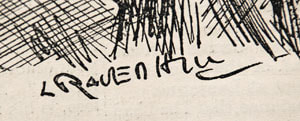
Leonard Raven Hill (1867-1942)
Leonard Raven Hill studied art at the Lambeth School, with fellow Punch contributor F H Townsend, and at the Académie Julian, Paris. He was well established as both cartoonist and illustrator by the time he began submitting work to Punch in 1896. In 1910, Raven Hill assumed the role of junior cartoonist following Bernard Partridge’s promotion to principal cartoonist.
‘When Raven Hill began to draw for Punch as a regular illustrator, he was already a busy pictorial journalist. Punch only very gradually became his main concern… In his cartoons, profiles were firmly drawn. Motion was convincing. There were few of the props with which it was traditional to clutter up the scene. Every part of a Raven Hill cartoon was there for the purpose of some effect. Evoe [E V Knox, Punch Editor from 1932 to 1949] has said: ‘He has done some wonderfully forceful and vivid stuff, and was a great foil to Bernard Partridge. I think he reached a splendid peak of performance during the war.’ His friend [Rudyard] Kipling chose him to illustrate Stalky.’ (Price, 1957).
Collections
Birmingham Museum and Art Gallery
British Museum
Victoria and Albert Museum
Sources and further reading
Bryant M and Heneage S (1994), Dictionary of British Cartoonists and Caricaturists 1730-1980, Scolar Press
Dolman B (1981), A Dictionary of British Artists, 1929, Antique Collectors’ Club
Johnson J and Greutzner A (1999), British Artists 1880-1940, Antique Collectors’ Club
Price R G G (1957), A History of Punch, Collins
Waters G M (1975), Dictionary of British Artists 1900-1950, Eastbourne Fine Art
Leonard Raven Hill studied art at the Lambeth School, with fellow Punch contributor F H Townsend, and at the Académie Julian, Paris. He was well established as both cartoonist and illustrator by the time he began submitting work to Punch in 1896. In 1910, Raven Hill assumed the role of junior cartoonist following Bernard Partridge’s promotion to principal cartoonist.
‘When Raven Hill began to draw for Punch as a regular illustrator, he was already a busy pictorial journalist. Punch only very gradually became his main concern… In his cartoons, profiles were firmly drawn. Motion was convincing. There were few of the props with which it was traditional to clutter up the scene. Every part of a Raven Hill cartoon was there for the purpose of some effect. Evoe [E V Knox, Punch Editor from 1932 to 1949] has said: ‘He has done some wonderfully forceful and vivid stuff, and was a great foil to Bernard Partridge. I think he reached a splendid peak of performance during the war.’ His friend [Rudyard] Kipling chose him to illustrate Stalky.’ (Price, 1957).
Collections
Birmingham Museum and Art Gallery
British Museum
Victoria and Albert Museum
Sources and further reading
Bryant M and Heneage S (1994), Dictionary of British Cartoonists and Caricaturists 1730-1980, Scolar Press
Dolman B (1981), A Dictionary of British Artists, 1929, Antique Collectors’ Club
Johnson J and Greutzner A (1999), British Artists 1880-1940, Antique Collectors’ Club
Price R G G (1957), A History of Punch, Collins
Waters G M (1975), Dictionary of British Artists 1900-1950, Eastbourne Fine Art